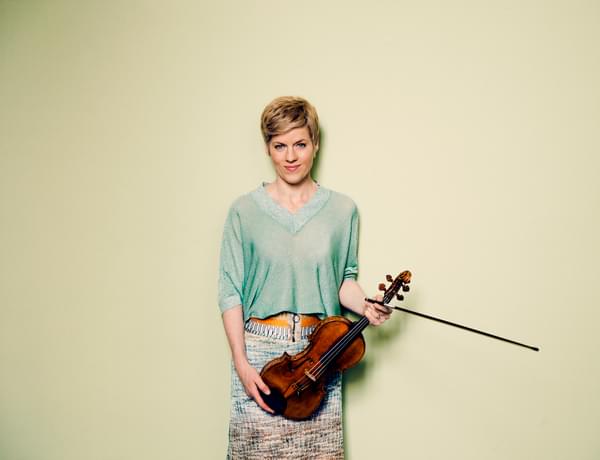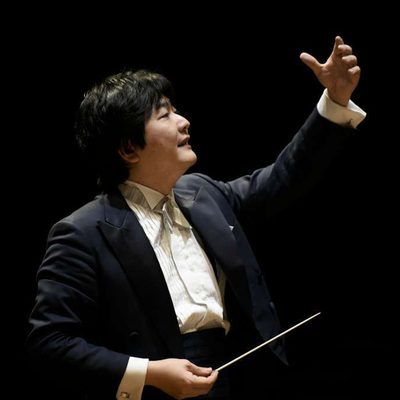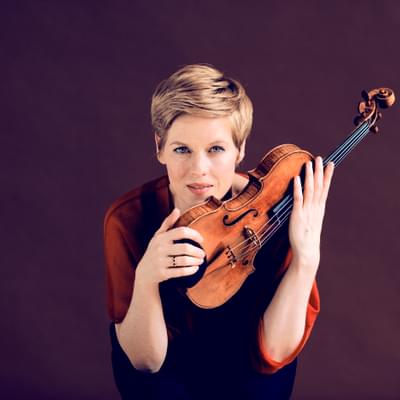Kazuki conducts Shostakovich & Bartók

Full programme
- Bartók, Dance Suite (17mins)
- Shostakovich, Violin Concerto No.2 (33mins)
- Yashiro, Symphony for Large Orchestra (UK Premiere) (32mins)
Performers

Kazuki Yamada
Conductor
Isabelle Faust
Violin
Introduction
It’s been four months since I joined the CBSO. The more concerts I do, the more enthusiastic and engaged I feel in the performances! Through everyone playing together, with the full sound of the orchestra, the music is brought to life - I hope this energy comes across to you all as well.
Tonight’s programme explores the depth of the 20th century.
Bartók has been my idol for a long time. Using old Hungarian (and other) folk music as a tool in his own music, his Dance Suite explores many different characters between movements. I especially love the energy of the last movement!
I really look forward to playing with the wonderful violinist Isabelle Faust who will be performing Shostakovich’s second violin concerto. I particularly adore the lyricism of this piece. Surprisingly, it is much less frequently played than his first violin concerto, yet I find both works equally fascinating.
Even though I’m originally from Japan I have never had the a chance to perform Yashiro’s symphony! What I find most intriguing about this piece is its combination of beauty and complex intensity.
These three composers all lived through chaotic and complex times of war. Each of them faced great hardship but sought to express their own personal musical voice with immense dedication. As a result, we are gifted a musical heritage full of explosive passion, testament to everything they loved.
Every time I get to play music of this era, I journey through the emotions of darkness, pain and intensity which lie at its heart. These sensations turn into streams, which ultimately, by the end of each piece, fill me with a boundless energy. This to me almost feels like the sun shining fully on the earth, giving me such positivity for life, moving forward.
I hope each of you can find your moment in today’s programme!
Yuriko Matsuda
Violin
Programme notes
Bartók’s lively Dance Suite was written in 1923 to remember the joining of Buda and Pest 50 years earlier. With the CBSO and Kazuki Yamada it glows and dances with Hungarian folk-like rhythms and melodies. Shostakovich’s Violin Concerto No.2 – a blend of fire and ice – is perfect for the supreme artistry of Isabelle Faust. In the second half, Akio Yashiro celebrates the entire Orchestra in his symphony.
Dance Suite
Béla Bartók (1881-1945)
Bartók’s vivacious Dance Suite was composed in 1923 to mark the 50th anniversary of the joining of Buda, Pest and Óbuda – three originally distinct cities alongside the River Danube in Hungary. Bartók had been invited to contribute to the grand celebrations along with fellow Hungarian composers Kodaly and Dohnanyi; of the three works presented, Kodaly’s choral piece Psalmus Hungaricus got the most critical praise, with Bartók’s Suite suffering – as so many premiered works did – from too little rehearsal. However, this characterful work became considerably more successful in the following years, and in some ways is a precursor to his famous Concerto for Orchestra written twenty years later.
All of the movements are inspired by a variety of folk music traditions, though the actual melodies were Bartók’s own. The opening movement – in an ‘Arabian’ style – begins with a melodramatic drumroll and ‘glissandi’ (or slide) down the piano keys, before introducing a jaunty stroll for two bassoons. Their melody is underpinned by rhythmic stabs from the strings. More woodwind solos follow, with the strings effectively functioning like a percussion section. The movement closes with a softly lyrical ‘ritornello’ passage, which recurs throughout; its first appearance is scored for muted strings, joined by a melancholy clarinet.
The second movement – in a Hungarian style - has a spiky, even aggressive character; at a 1926 performance in London there was some pearl-clutching from the Times critic, who objected to the snarky trombone slides (‘It is time that some protest was registered against glissandos on the trombones,’ he wrote, disapprovingly). Again, the ritornello softens the movement’s rough edges. Bartók described the boisterous third movement as ‘Hungarian-Romanian-Arab’, its eclectic influences reflected in its colourful orchestration (including at one point celeste and harp over a trilling flute). The ritornello does not appear in the same form here, only hinted at in passing by the flute before the final ‘Vivacissimo’ section.
The ‘Arabian’ style returns for the enigmatic fourth movement, with the woodwind again taking the solo spots over a shimmering backdrop of muted strings. A high-lying, atmospheric version of the ritornello closes the movement. A minute-long passage marked ‘Comodo’ (and describe by the composer as ‘Primitive’) gradually creeps into earshot, heralding the arrival of the ‘Finale’ and a diabolical argument between brass instruments. The full orchestra assembles, playing themes from earlier in the Suite in swift succession (as in the previous movement, the ritornello appears mid-stream rather than at the end). The mood becomes increasingly good-humoured as the finale romps to a breathless conclusion.
Dmitri Shostakovich (1906-1975)
Violin Concerto No.2
Shostakovich wrote Violin Concerto No.2 in 1967 for David Oistrakh, the dedicatee and first soloist of the first concerto, composed some twenty years earlier. (No. 2 was intended as a 60th birthday present to Oistrakh, but Shostakovich absent-mindedly miscalculated and ended up giving it to him for his 59th.) Like the first concerto, the second has a prominent role for the horn which, depending on mood, acts as a counterpart, sparring partner or comrade to the violin soloist. The work has an introspective, somewhat hushed quality, perhaps reflective of Shostakovich’s failing health – he had had a heart attack the previous year. The orchestral forces are modest, with no brass other than horns and the percussion section comprising only timpani and tom-tom (which has a particularly prominent role in the finale). As often in Shostakovich’s symphonic works, numbers are periodically reduced to even smaller gatherings, such as the intimate groupings of piccolo, solo violin and horn in the first movement.
It opens with a rumbling figure in the strings, over which the soloist’s first melody appears. This soulful passage seems initially to be one of Shostakovich’s characteristically long-breathed tunes, yet it is gradually taken over – as if infected – by the more ominous figures from the accompaniment. The piccolo introduces a lively five-note theme after a few minutes, with counter-contributions from the horn and violin; yet the combination of all three has, overall, a prickly rather than jaunty quality. The tom-tom contributes a further hard edge as the movement progresses, in increasingly nervous fashion. The violin – which has barely a break in this movement – embarks on a series of fiendish double-stops (two notes played at the same time), before the ensemble abruptly stops, giving way to the first of three solo cadenzas. The movement closes in a hushed, fragmentary way, with muted hints of the various themes.
The slow movement emerges from this pared-down texture, with low strings and solo violin, joined shortly by a solo flute. The texture gradually thickens, becoming richer and gaining in volume, but does not (yet) reach a peak; instead, the chamber-like groupings dominate, including the soloist duetting with bassoon then timpani before the second cadenza. The soloist finally gets a breather in the final bars of the movement during a beautiful, lengthy horn solo, which concludes with a hand-stopped echo of the final bars.
After such inwardness, the last movement is something of a change of a pace. Opening with a brisk exchange between soloist and muted horn, it is in some ways characteristic of so many of Shostakovich’s blistering finales. Yet its raucousness is often held in check, with brief bursts of sounds – including a few bars for the whole ensemble - rather than a sustained fever pitch. The final cadenza is the longest, lasting some three minutes, followed by the build towards the conclusion. As if finally unleashed, the orchestral forces reassemble, led by an insistent tom-tom to the hectic final bars.
Symphony for Large Orchestra
Akio Yashiro (1929-1976)
In the early 2000s the recording label Naxos developed a series of ‘Japanese Classics’, with the aim of introducing audiences to a huge range of Japanese classical music, much of it not heard outside its home country. Akio Yashiro’s Symphony (and Piano Concerto) were among these recordings. Yashiro, possibly not as well-known as his near contemporary Tōru Takemitsu, shared with his compatriot a fascination with French composers, especially Messiaen. Yashiro studied in France with both Messiaen and Nadia Boulanger in the early 1950s before returning to Japan to work and teach. His only Symphony was composed in 1958 for the Japan Philharmonic Society Orchestra, and is being performed in the UK for the first time in this concert.
The first movement recycles an earlier, unfinished work inspired by Oscar Wilde’s Salome; appropriate to the hothouse atmosphere of the play the movement is slow-moving and sensuous, revolving meditatively around the note of ‘B’, the basis of several of the Symphony’s themes. The second movement is a breathless ‘moto perpetuo’, based on repetitions of an infectiously dance-like rhythm, almost Bernstein-like by the end in its visceral presentation by the whole orchestra. Following, and in stark contrast, is a lengthy and melancholy slow movement, initiated by a magical combination of cor anglais and bass flute. Other groups of instruments merge into the texture, accompanied atmospherically by the vibraphone. The movement as a whole comprises a series of contrasting themes and sound worlds, palpably reflecting the influence of Messiaen in the softly shifting, muted string chords. The finale begins slowly – an ominous growling from the low instruments, some whoops from the flutes and brass – until bells herald the start of something very different. The movement becomes a spirited romp, bristling with tricky syncopated rhythms and vibrant orchestral effects, building towards a celebratory – bordering on bacchanalian – conclusion, heavy on the tam-tams.
© Lucy Walker